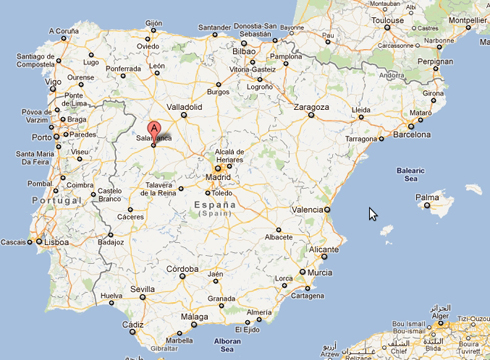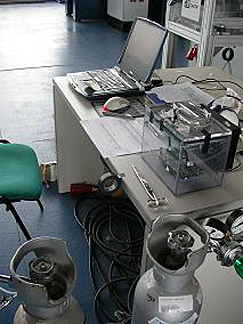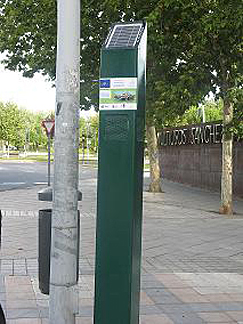Home / Casos de Éxito / Proyecto Smart City en Salamanca para vigilar la calidad del aire y el tráfico urbano
Hoy en día, el mayor porcentaje de contaminación atmosférica procede directamente del tráfico rodado y ya no de las grandes industrias, situadas actualmente fuera de las áreas metropolitanas y urbanas. Se considera que el tráfico rodado es responsable de 25% de todas las emisiones en Europa, llegando a 31% sólo en España. Además, 90% de todas las emisiones del transporte se deben al tráfico por carretera. La pérdida de calidad del medio ambiente es una de las mayores amenazas de nuestro siglo para la salud y el bienestar humano, junto con los impactos ambientales. Waspmote realiza un seguimiento de los parámetros medioambientales en la ciudad de Salamanca.
Las investigaciones aconsejan que el actual aumento de las enfermedades respiratorias y otras relacionadas se deba a la contaminación atmosférica, así como al aumento de las alergias que merman en tantos aspectos la calidad de vida de las personas. Según datos oficiales de la Unión Europea, 225.000 personas murieron en Europa por enfermedades relacionadas con las emisiones de los coches. De ellas, 15.000 sólo en España, lo que multiplica por cinco la mortalidad por accidente de tráfico. Para superar esta amenaza, la legislación de la Unión Europea se ha vuelto más estricta y pretende reducir las emisiones de los coches en 20% hasta 2020.
Como la Agencia Europea de Medio Ambiente (EEE) afirma: "El ozono y las partículas son los contaminantes más problemáticos para la salud, ya que pueden causar o agravar enfermedades cardiovasculares y pulmonares y provocar muertes prematuras. La eutrofización, un exceso de nitrógeno nutriente en los ecosistemas terrestres y acuáticos, es otro de los principales problemas causados por los contaminantes atmosféricos. Los óxidos de nitrógeno (NOx) procedentes de los procesos de combustión son actualmente los principales contaminantes atmosféricos acidificantes y eutrofizantes, ya que la contaminación por azufre ha disminuido en los últimos años".

A recent EEA report establishes that approximately 17 % of European citizens live in areas where the EU target for ozone concentration was exceeded in 2009. If ozone levels are compared to the more stringent World Health Organization (WHO) guidelines, more than 95% of the EU urban population was exposed to ozone exceeding this level. This report also says that 12% of the European urban population live in areas with urban background (non-traffic) concentrations of NO2 exceeding EU and WHO levels.
Proyecto RESCATAME
Red omnipresente de sensores de calidad del aire para una gestión del tráfico urbano respetuosa con el medio ambiente (RESCATAME) es un proyecto financiado por la Unión Europea a través de su programa LIFE. El Consorcio está formado por los siguientes miembros: CARTIF, Red europea de CEEI, Ayuntamiento de Salamanca y Grupo Consultivo de Investigación P&G. Su principal objetivo es conseguir una gestión sostenible del tráfico en la ciudad de Salamanca utilizando dos elementos clave: una red de sensores de calidad del aire omnipresente y modelos de predicción.

Fig. 1.- Ubicación de RESCATAME
La red omnipresente de sensores de calidad del aire se está probando actualmente en la ciudad de SALAMANCA (España), donde el impacto positivo esperado en la reducción de los niveles de contaminación del aire mejora la salud humana y el medio ambiente, pero también la reducción de los impactos de la contaminación en los monumentos del patrimonio mundial que hacen que la ciudad sea muy famosa, como Patrimonio de la Humanidad de la UNESCO desde 1988 y Capital Europea de la Cultura en 2002.
El proyecto está recopilando datos para demostrar que, utilizando los datos recogidos por los sensores situados por toda la ciudad, que proporcionan cobertura a tiempo completo y geográficamente a bajo coste, los ayuntamientos pueden conseguir de forma eficaz una mejor gestión del tráfico urbano en las grandes ciudades europeas.
La solución
Este proyecto puede explicarse mejor con el siguiente diagrama:

Fig. 2.- Diagrama de solución
Se desplegaron 35 Waspmote en dos lugares diferentes, midiendo 7 parámetros:
Estos 7 sensores se conectan al Waspmote a través de una Placa de Sensores especial fabricada para este proyecto, que contiene la electrónica necesaria para implementar una fácil integración hardware de estos sensores.

Fig. 3.- Placa de sensores diseñada para el proyecto RESCATAME
Esta placa de sensores se ha diseñado específicamente para cumplir los requisitos de este proyecto, ya que Libelium proporciona personalizado diseño de hardware.
La etapa de amplificación de cada sensor es trimable, para permitir una mejor integración del sensor específico, ya que puede haber variaciones de un sensor a otro del mismo modelo. Además, esta característica permite centrar la precisión del Waspmote en una región de interés. Además, es posible encender cada sensor por separado, ya que sus líneas de alimentación son independientes y pueden controlarse mediante Waspmote en tiempo real.
Si alguno de estos 7 parámetros supera un umbral, el sistema analiza la información y puede reaccionar enviando una alarma al nodo central (Meshlium en este caso). Para saber dónde se encuentra este sensor, cada Waspmote puede integrar un GPS, que proporciona información precisa sobre la posición y la hora.
Libelium ofrece varios módulos inalámbricos para el comunicación por radio:
|
Modelo |
Protocolo |
Frecuencia |
Potencia TX |
Sensibilidad |
Gama* |
|
XBee-802.15.4 |
802.15.4 |
2,4 GHz |
1 mW |
-92 dB |
500 m |
|
XBee-802.15.4-Pro |
802.15.4 |
2,4 GHz |
63 mW |
-100 dBm |
7000 m |
|
XBee-ZigBee |
Zigbee-Pro |
2,4 GHz |
2 mW |
-96 dBm |
500 m |
|
XBee-ZigBee-Pro |
Zigbee-Pro |
2,4 GHz |
50 mW |
-102 dBm |
7000 m |
|
XBee-868 |
RF |
868 MHz |
315 mW |
-112 dBm |
12 km |
|
XBee-900 |
RF |
900 MHz |
50 mW |
-100 dBm |
10 km |
|
XBee-XSC |
RF |
900 MHz |
100 mW |
-106 dBm |
12 km |
Fig. 4.- Distancias alcanzadas en función del protocolo
El módulo de 868 MHz permite alcanzar hasta 40 km en condiciones de línea de visión directa (LOS). El alto rendimiento del Waspmote hace que las lecturas sean muy precisas y la transmisión muy fiable y flexible.
También es posible transmitir los datos a través de GPRS, como módulo de radio secundario para una mejor disponibilidad y redundancia en situaciones en las que es crítico asegurar la recepción del mensaje, como posibles alarmas de incendio. El módulo GPRS es cuatribanda (puede operar en 4 bandas diferentes, por lo que es compatible con cualquier proveedor de conexión celular), por lo que puede funcionar en todo el mundo, por lo que este proyecto que estamos describiendo es apto para cualquier país.
Una de las principales características del Waspmote es su bajo consumo:
El Waspmote está en modo de reposo la mayor parte del tiempo, para ahorrar batería. Al cabo de unos minutos (programables por el usuario), Waspmote se despierta, lee de los sensores, implementa la comunicación inalámbrica y pasa de nuevo al modo de reposo. Cada dispositivo se alimenta con baterías recargables y un panel solar, lo que hace que el sistema sea muy autónomo.
2 Meshliums se utilizaron para recoger los datos de los distintos nodos y enviarlos por GPRS. Meshlium es el único router multiprotocolo del mundo capaz de interconectar hasta 5 tecnologías:
Meshlium implementa una conexión sencilla entre estos 5 protocolos de comunicación. En este caso, recoge la información de la red inalámbrica Waspmote ZigBee y la envía al Centro de Control a través de WiFi.
La carcasa IP65 de Meshlium le permite trabajar en condiciones de intemperie. En cuanto a la fuente de alimentación, se puede conectar a un panel solar o al encendedor de un coche, para que pueda funcionar sin problemas en exteriores. La batería de cada Waspmote permite una vida operativa de muchos meses o incluso años sin ninguna fuente de alimentación como el sol, dependiendo del tiempo que el Waspmote esté encendido. Sin embargo, si hay un panel solar, el Waspmote puede funcionar indefinidamente en teoría.
Cuando las tramas llegan a Meshlium, entonces éste implementa un parseo, dividiendo todos los datos en pequeños trozos o variables que se almacenan en una Base de Datos del Servidor MySQL. Una vez guardados los datos en la Base de Datos, entonces es posible gestionarlos de la forma que necesitemos.
Proceso de implantación
Para obtener una medición precisa, los sensores se han calibrado en laboratorios profesionales con el fin de ofrecer los mejores resultados en este proyecto. En palabras de uno de los socios (CARTIF), "el mayor problema al que nos hemos enfrentado en este proyecto ha estado relacionado con la calibración de los sensores, ya que no hay empresas disponibles para llevar a cabo este proceso". Para solucionar este inconveniente, "han desarrollado sus propios métodos de calibración".

Fig. 5.- Proceso de calibración
Una vez calibrados, los nodos sensores se colocaron en su carcasa exterior y se probaron tanto en interiores como en exteriores.
Fig. 6.- Proceso de prueba
Una vez que los nodos sensores han sido validados por un gran número de pruebas, fueron desplegado en dos calles de la Ciudad de Salamanca, dividiéndose en dos grupos de 25 y 10 sensores cada uno.

Fig. 7.- Nodo instalado en Salamanca
Estos nodos se alimentan de un panel solar y un regulador externo que se conecta a una batería. Aprovechando las funciones de ahorro de energía del Waspmote y la energía solar, estas motas son autónomas.
Para ayudar en la transmisión de los datos, también se instalaron 2 Meshlium, que recogen la información y la envían por GPRS.
En palabras de uno de los miembros de RESCATAME, "el sistema de control de la contaminación y el tráfico desarrollado en el marco del proyecto RESCATAME consta de 6 partes: seguimiento, modelización, análisis estadístico, difusión, despliegue y evaluación". Uno de los objetivos de RESCATAME es "crear una plataforma de datos para informar, comprender, valorar y evaluar el impacto de las acciones aplicadas para mejorar la accesibilidad, abordar los problemas de congestión, mejorar la calidad del aire y poner en marcha un Sistema de Información del Tráfico".
El proyecto RESCATAME ha creado una base de datos externa para almacenar los datos de los dos Meshlium con el fin de mostrar los datos de los sensores en una aplicación web. Estos datos de los sensores se utilizarán en los modelos predictivos para poder mejorar la gestión del tráfico.
Dado que Waspmote se ajusta a todos sus requisitos, RESCATAME "decidió utilizar la plataforma Waspmote por ser la que más se acercaba a nuestras necesidades y ser un proveedor español".